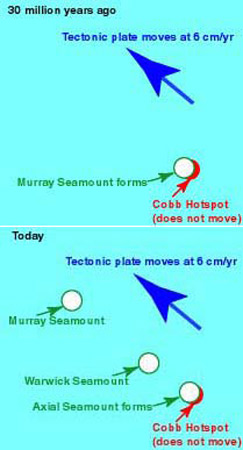A volcanic mountain is building off the coast of Oregon. It sits atop a “hotspot” -- a bubble of hot rock far beneath the ocean floor. The lava pushes through the plate of rock that forms the Pacific basin, and piles up to form a mountain.
 Chain of seamounts formed by the Cobb Hotspot. Credit: National Oceanic and Atmospheric Administration
Chain of seamounts formed by the Cobb Hotspot. Credit: National Oceanic and Atmospheric AdministrationIt’s a process that’s played out many times over the last 40 million years or so. It’s built up an entire chain of submerged mountains, known as seamounts. They stretch hundreds of miles to the northwest, far into the Gulf of Alaska. Some of them rise up to two miles high, and come to within a few hundred feet of the surface.
There are several chains of seamounts in the Gulf of Alaska. Each chain was built by its own hotspot. That’s because the tectonic plate that forms the Pacific basin is sliding steadily to the northwest. As it does so, a seamount moves away from the hotspot and shuts down. But a new one builds up in its place. It’s the same process that gave birth to the Hawaiian Islands -- and continues to build up the chain even now.
The Gulf of Alaska seamounts are teeming with life. Scientists have found thriving colonies of coral, plus fish, sponges, worms, crabs, and many other creatures.
Ridges along the seamounts provide solid surfaces for corals to grow on. And the corals, along with cracks in the rock, provide shelter for the other organisms.
The seamounts also act like funnels for nutrient-rich water. As water currents hit the mountains they’re pushed upward along the flanks -- supporting rich colonies of life on undersea mountains.

